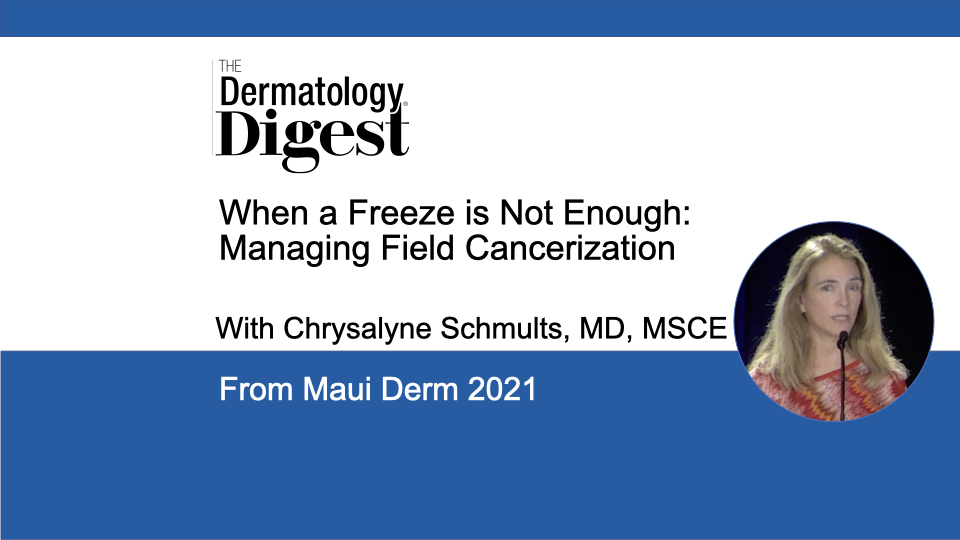Dr. Chrysalyne Schmults discusses a field treatment approach to AK and SCC in situ that improves efficacy and patient quality of life.
Chrysalyne Schmults, MD, MSCE, is an associate professor of dermatology at Brigham and Women’s/Dana Farber Cancer Center and Harvard Medical School.
“For me, AK and squam in situ are really the same thing clinically. They’re a spectrum of disease that one blends right into the other. And because they’re both limited to the epidermis, I approach their treatment in the same way,” says Chrysalyne Schmults, MD, MSCE.
In her presentation, “When a Freeze is Not Enough: Managing Field Cancerization,” at Maui Derm 2021, Dr. Schmults outlines a research-based approach to field cancerization treatment that shortens the 5-FU treatment course and adds topical calcipotriol for increased efficacy and patient quality-of-life improvements.
Of four common field cancerization treatments—PDT (now defunct), ingenue mebutate, imiquimod, and classic 5% 5-FU — 5% 5-FU was shown to be the most effective, with 75% of patients recurrence-free with AKs at one year in a recent study.1
Another study2 of 5% 5-FU showed a 75% clearance of dermally invasive squamous cell cancer, but with limited duration, which points out the chronicity of the disease.
“This is a patient population that you’re going to have to treat over and over again, some of our more severe patients will actually have them retreating, even as often as every six months. Most patients are going to only have to do it about every other year or so. But if you really want to maintain this reduction in squamous cell cancer formation, you need to keep constantly combat in the field cancerization.”
To improve the conditions of ongoing field cancerization treatment, another study Dr. Schmults cites examines adding calcipotriol to a modified—from 4 weeks to 4 days—5-FU treatment course.3 Study authors found memory T cells present in the skin three years after the the combination calcipotriol and 5% 5-FU treatment and believe it somehow recruits T cells to the area for long-term immunologic surveillance in the skin.
“This is such an abbreviated treatment course patients are all healed up within two weeks. And a lot of these patients have already been put through the four-week treatment repeatedly. And so to have something where they only have two weeks of downtime is just a total game changer for them.”
Finally, Dr. Schmults says her field cancerization patients also take nicotinamide 500 mg twice a day based on a trial4 that showed a 30% reduction in squamous cell cancer for patients who supplemented with this vitamin B3 analogue.
And for those patients who still continue to battle dermally invasive squamous cell cancer, on the order of a handful of tumors a year, it may be time for oral retinoids.
References
- Jansen MHE, Kessels JPHM, Nelemans PJ, et al. Randomized Trial of Four Treatment Approaches for Actinic Keratosis. N Engl J Med. 2019 Mar 7;380(10):935-946. doi: 10.1056/NEJMoa1811850.
- Weinstock MA, Thwin SS, Siegel JA, Marcolivio K, et al. Chemoprevention of Basal and Squamous Cell Carcinoma With a Single Course of Fluorouracil, 5%, Cream: A Randomized Clinical Trial. JAMA Dermatol. 2018 Feb 1;154(2):167-174. doi: 10.1001/jamadermatol.2017.3631.
- Rosenberg AR, Tabacchi M, Ngo KH, et al. Skin cancer precursor immunotherapy for squamous cell carcinoma prevention. JCI Insight. 2019 Mar 21;4(6):e125476. doi: 10.1172/jci.insight.
- Chen AC, Martin AJ, Choy B, et al. A Phase 3 Randomized Trial of Nicotinamide for Skin-Cancer Chemoprevention. N Engl J Med. 2015 Oct 22;373(17):1618-26. doi: 10.1056/NEJMoa1506197.


